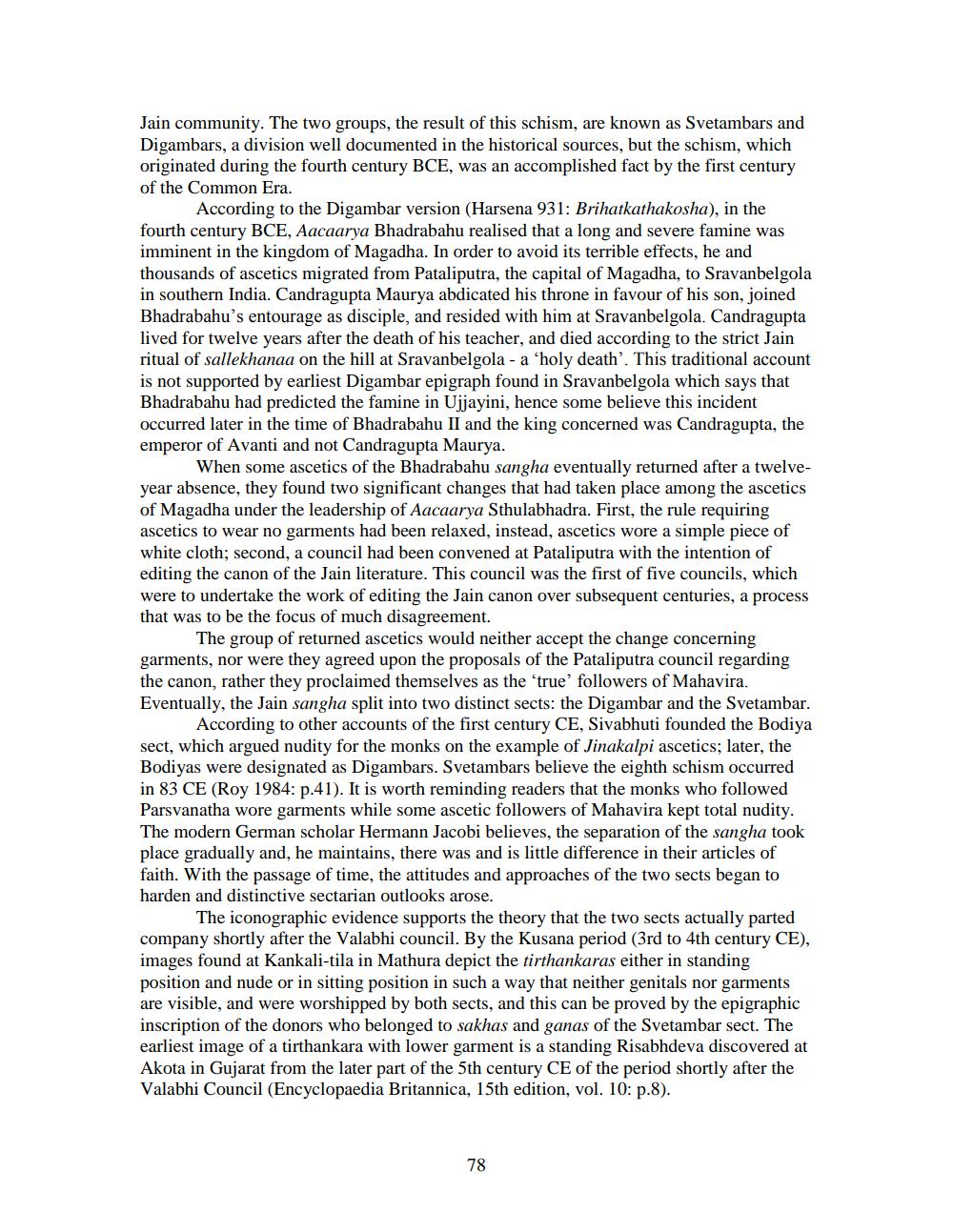________________
Jain community. The two groups, the result of this schism, are known as Svetambars and Digambars, a division well documented in the historical sources, but the schism, which originated during the fourth century BCE, was an accomplished fact by the first century of the Common Era.
According to the Digambar version (Harsena 931: Brihatkathakosha), in the fourth century BCE, Aacaarya Bhadrabahu realised that a long and severe famine was imminent in the kingdom of Magadha. In order to avoid its terrible effects, he and thousands of ascetics migrated from Pataliputra, the capital of Magadha, to Sravanbelgola in southern India. Candragupta Maurya abdicated his throne in favour of his son, joined Bhadrabahu's entourage as disciple, and resided with him at Sravanbelgola. Candragupta lived for twelve years after the death of his teacher, and died according to the strict Jain ritual of sallekhanaa on the hill at Sravanbelgola - a 'holy death'. This traditional account is not supported by earliest Digambar epigraph found in Sravanbelgola which says that Bhadrabahu had predicted the famine in Ujjayini, hence some believe this incident occurred later in the time of Bhadrabahu II and the king concerned was Candragupta, the emperor of Avanti and not Candragupta Maurya.
When some ascetics of the Bhadrabahu sangha eventually returned after a twelveyear absence, they found two significant changes that had taken place among the ascetics of Magadha under the leadership of Aacaarya Sthulabhadra. First, the rule requiring ascetics to wear no garments had been relaxed, instead, ascetics wore a simple piece of white cloth; second, a council had been convened at Pataliputra with the intention of editing the canon of the Jain literature. This council was the first of five councils, which were to undertake the work of editing the Jain canon over subsequent centuries, a process that was to be the focus of much disagreement.
The group of returned ascetics would neither accept the change concerning garments, nor were they agreed upon the proposals of the Pataliputra council regarding the canon, rather they proclaimed themselves as the 'true' followers of Mahavira. Eventually, the Jain sangha split into two distinct sects: the Digambar and the Svetambar. According to other accounts of the first century CE, Sivabhuti founded the Bodiya sect, which argued nudity for the monks on the example of Jinakalpi ascetics; later, the Bodiyas were designated as Digambars. Svetambars believe the eighth schism occurred in 83 CE (Roy 1984: p.41). It is worth reminding readers that the monks who followed Parsvanatha wore garments while some ascetic followers of Mahavira kept total nudity. The modern German scholar Hermann Jacobi believes, the separation of the sangha took place gradually and, he maintains, there was and is little difference in their articles of faith. With the passage of time, the attitudes and approaches of the two sects began to harden and distinctive sectarian outlooks arose.
The iconographic evidence supports the theory that the two sects actually parted company shortly after the Valabhi council. By the Kusana period (3rd to 4th century CE), images found at Kankali-tila in Mathura depict the tirthankaras either in standing position and nude or in sitting position in such a way that neither genitals nor garments are visible, and were worshipped by both sects, and this can be proved by the epigraphic inscription of the donors who belonged to sakhas and ganas of the Svetambar sect. The earliest image of a tirthankara with lower garment is a standing Risabhdeva discovered at Akota in Gujarat from the later part of the 5th century CE of the period shortly after the Valabhi Council (Encyclopaedia Britannica, 15th edition, vol. 10: p.8).
78




